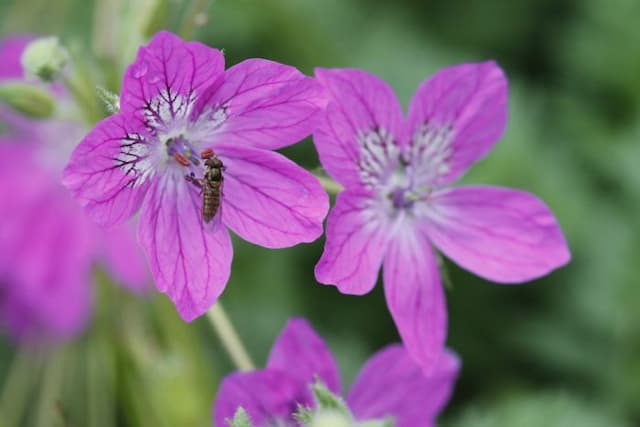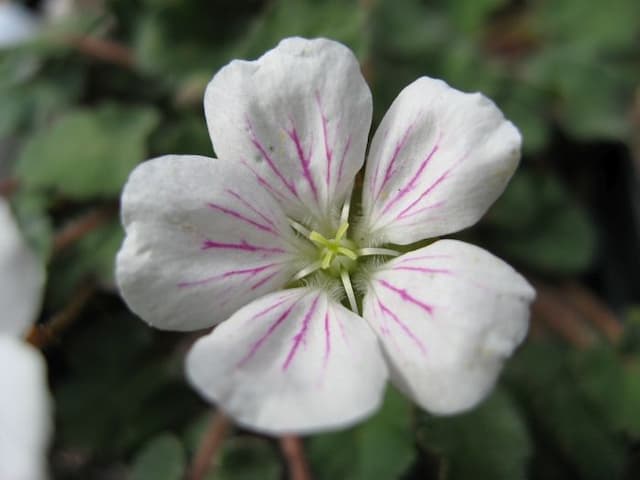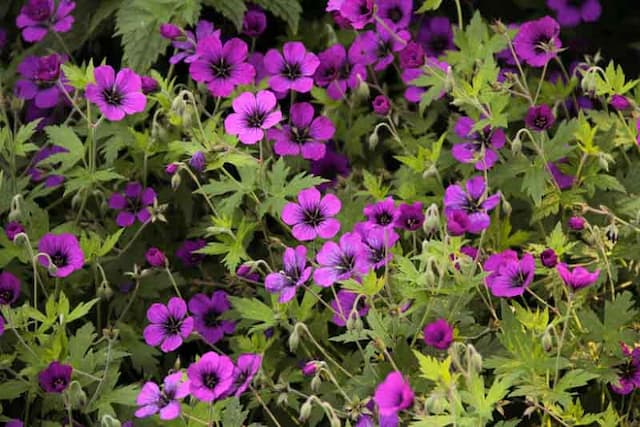Geranium Pelargonium transvaalense

ABOUT
Pelargonium transvaalense is commonly known as the Transvaal Geranium. It is a distinctive and attractive plant with an appealing aesthetic. The plant features lobed leaves that are soft to the touch, with their edges often exuding a subtly scalloped or toothed appearance. These leaves usually display a rich, deep green color, and they may have a slightly hairy or velvety texture, with the undersides sometimes showing a lighter green hue. The Transvaal Geranium is renowned for its floral display, showcasing umbels, which are clusters of small flowers borne on a stalk. The flowers exhibit a variety of vibrant colors such as pink, purple, red, or white, and they are notable for their rounded petals, which may be accented with darker colored markings or veins. The blooms typically have five symmetrical petals, with the upper two often being larger or more pronounced than the lower three. At the center of each flower is a cluster of reproductive organs, including stamens and a pistil, which are typically surrounded by a burst of stamens with visible anthers at their tips. These structures emerge from the flowers in a striking display, often contributing to the plant’s overall ornamental appeal. This Geranium is also characterized by its fragrance. The leaves of the Transvaal Geranium may release a pleasant aroma when crushed or brushed against, which enriches the sensory experience of the plant. This scent can vary and may be reminiscent of citrus, mint, or other herbal notes. All in all, the Transvaal Geranium is a visually attractive plant with distinctive characteristics, such as its toothed leaves, colorful flowers, and fragrant leaves, making it a popular choice for ornamental purposes in suitable climates.
About this plant
 Names
NamesSynonyms
Transvaal Geranium, Wildemalva
Common names
Pelargonium transvaalense
 Toxicity
ToxicityTo humans
Pelargonium transvaalense, commonly known as geranium, is generally not considered toxic to humans. However, ingestion of plant parts can sometimes cause mild gastrointestinal upset, such as vomiting or diarrhea. Handling the plant may also cause skin irritation in some people due to sensitivity to the oils or sap. It is always advisable to practice caution and keep plants out of reach of children who may accidentally ingest plant material.
To pets
Geraniums, including Pelargonium transvaalense, are considered somewhat toxic to pets such as dogs and cats. If ingested, they can cause symptoms such as vomiting, anorexia, depression, and dermatitis. These symptoms are typically mild to moderate in severity, but it is important to keep these plants out of reach of pets and to consult a veterinarian if any signs of toxicity are observed.
 Characteristics
CharacteristicsLife cycle
Perennials
Foliage type
Evergreen
Color of leaves
Green
Flower color
Pink
Height
1-2 feet (30-60 cm)
Spread
1-2 feet (30-60 cm)
Plant type
Herb
Hardiness zones
10
Native area
South Africa
Benefits
 General Benefits
General Benefits- Aesthetic Appeal: Adds vibrant color and unique beauty to gardens and landscapes with its striking flowers and foliage.
- Habitat for Wildlife: Provides nectar and shelter for beneficial insects, such as bees and butterflies.
- Drought Tolerance: Well-suited for xeriscaping and water-wise gardens due to its ability to withstand periods of drought once established.
- Easy Propagation: Can be easily propagated from cuttings, allowing gardeners to expand their collection without additional cost.
- Low Maintenance: Requires minimal care, making it suitable for busy gardeners or those with limited gardening experience.
- Container Gardening: Ideal for growing in pots, which makes it a versatile choice for balconies, patios, and other small spaces.
- Long Blooming Period: Offers a long season of blooms, providing continuous color throughout the warmer months.
- Fragrance: Some varieties may have scented leaves, which can add a pleasant aroma to the garden or home when used in indoor arrangements.
- Versatility: Suitable for use in mixed borders, flower beds, and as a focal plant, providing flexibility in garden design.
 Medical Properties
Medical PropertiesThis plant is not used for medical purposes.
 Air-purifying Qualities
Air-purifying QualitiesThis plant is not specifically known for air purifying qualities.
 Other Uses
Other Uses- Potpourri Addition: The scented leaves of the Geranium can be dried and added to potpourri mixes to impart a pleasant fragrance to the mixture.
- Insect Repellant Sachets: Dried Geranium leaves can be used in small sachets to repel insects in wardrobes and drawers.
- Culinary Uses: Some Geranium species are edible and can be used to flavor jellies, cakes, and icing with their rose-like scent.
- Dye Source: The Geranium can be used as a natural dye source for fabrics, yielding a range of colors depending on the mordant used.
- Garden Companion Planting: Geraniums can be planted alongside vegetables like tomatoes to help repel pests due to their strong scent.
- Aromatherapy: The essential oil from Geranium leaves can be used in aromatherapy diffusers to create a calming atmosphere.
- Fragrance for Homemade Cosmetics: Geranium oil can be incorporated into homemade soaps, lotions, and shampoos for its fragrance and mild properties.
- Natural Fabric Softener: When used in the rinse cycle of laundry, Geranium leaves can naturally soften fabrics without chemicals.
- Fragrant Bouquets: Fresh Geranium leaves and flowers can be included in bouquets for their fragrance and to extend the vase life of cut flowers.
- Crafts and Decorations: Geranium flowers and leaves can be used to create natural wreaths, centerpieces, or other botanical craft projects.
Interesting Facts
 Feng Shui
Feng ShuiThe Geranium is not typically associated with Feng Shui practice.
 Zodiac Sign Compitability
Zodiac Sign CompitabilityThe Geranium is not used in astrology practice.
 Plant Symbolism
Plant Symbolism- Adaptability - Pelargonium transvaalense, commonly known as Geranium, often symbolizes adaptability due to its ability to thrive in a variety of conditions.
- Resilience - Geraniums are hardy plants that can represent resilience, as they bounce back from challenges and continue to flourish.
- Comfort - With their pleasant scent and attractive blooms, geraniums may represent comfort and the idea of providing solace in times of distress.
- Friendship - Geraniums have been associated with friendship, perhaps because of their long-lasting nature and the ease with which they blend into different environments, similar to a good friend.
 Water
WaterGeraniums, including Pelargonium transvaalense, prefer even moisture and should be watered when the top inch of soil feels dry. Generally, this might mean watering about once a week, but this can vary depending on climate and environmental conditions. It's best to water deeply, allowing about a half gallon of water for a standard 10-inch pot to ensure the soil is moist but not waterlogged. During hot, dry periods, the plants may need more frequent watering, possibly twice a week, whereas in cooler, cloudy weather, watering might be reduced. Always check the soil moisture level before watering to prevent overwatering, which can lead to root rot.
 Light
LightGeraniums like bright, indirect sunlight and can also tolerate some direct sun, but too much can cause leaf scorch. They thrive in a spot that receives at least 4 to 6 hours of sunlight a day. The best location would be near an east or west-facing window where they can enjoy morning or afternoon sun without the harsh midday exposure.
 Temperature
TemperatureGeraniums prefer temperatures between 65 and 75 degrees Fahrenheit during the day and should not drop below 55 degrees at night. They can handle occasional dips in temperature but are not frost-tolerant and will not survive if exposed to temperatures below freezing. To promote continuous blooming and robust growth, keeping the geraniums in their ideal temperature range is advisable.
 Pruning
PruningPruning geraniums encourages bushy growth and more frequent blooming. Remove dead flowers and leaves regularly to promote new growth. It's best to prune heavily in the spring to shape the plant and remove any dead or leggy growth. Pruning can be performed as needed throughout the growing season whenever you notice parts of the plant that are damaged or overgrown.
 Cleaning
CleaningAs needed
 Soil
SoilGeraniums such as Pelargonium transvaalense thrive in a soil mix that is well-draining and rich in organic matter, with a slightly acidic to neutral pH between 6.0 and 7.0. A mix of two parts peat moss or coco coir, one part perlite or coarse sand, and one part garden loam or compost is ideal for promoting healthy growth.
 Repotting
RepottingGeraniums should be repotted every one to two years to refresh the soil and provide room for root growth, or when the plant outgrows its current container. It's best to repot in spring before the growing season.
 Humidity & Misting
Humidity & MistingGeraniums prefer moderate humidity but can tolerate low humidity levels typical of indoor environments. Aim for humidity around 40-50%, avoiding overly humid conditions which can promote fungal diseases.
 Suitable locations
Suitable locationsIndoor
Place in bright light, avoid overwatering, and ensure good air circulation.
Outdoor
Full sun to part shade, protect from frost, well-draining soil.
Hardiness zone
10-11 USDA
 Life cycle
Life cycleThe life cycle of Pelargonium transvaalense, commonly known as the Transvaal Geranium, begins with seed germination, which requires a warm, well-drained soil environment and consistent moisture. After germination, the seedling grows into a young plant with characteristic velvety and aromatic leaves that form a rosette. As it matures, the plant develops a sturdy stem and branches, producing clusters of flowers that can be pink, purple or white, typical of the geranium family, which attract pollinators for reproduction. Following pollination, the flower produces fruit that contains seeds, completing the cycle of sexual reproduction. If the conditions are favorable, these seeds will disperse and germinate, starting the cycle anew. Throughout its life, the plant undergoes vegetative growth and may also propagate asexually through cuttings.
 Propogation
PropogationPropogation time
Spring-Early Summer
For the South African Geranium, also known as the Pelargonium transvaalense, the most popular method of propagation is through cuttings. This is generally done during the growing season, which is typically from spring to summer, to ensure the best chance of rooting. To propagate, take a cutting of about 4 to 6 inches (10 to 15 cm) from a healthy plant, ensuring to cut just below a leaf node. The bottom leaves are removed, and the cut end is dipped in rooting hormone to facilitate root development. The cutting is then planted in a moist potting mix and kept under indirect sunlight. It should be watered sparingly until the cutting has taken root, usually evident by new growth, which can take a few weeks to a couple of months. This method is simple and has a high success rate for the South African Geranium.









![Cranesbill [Rothbury Gem]](/_next/image?url=https%3A%2F%2Fplants-admin.emdemapps.com%2Fimages%2Fplants%2F%2Fimages%2F604b6243984c2.png&w=640&q=75)